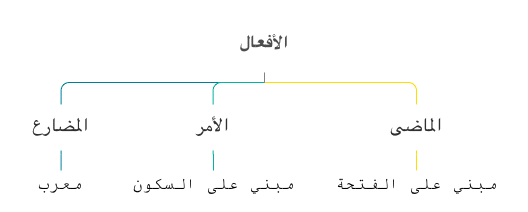Part 4: Verbs
Matn: Text of Al-Ājrūmīyyah
بَابُ الأَفْعَالِ
الأَفْعَالُ ثَلَاثَةٌ: مَاضٍ، وَمُضَارِعٌ، وَأَمْرٌ، نَحْوَ: ضَرَبَ، وَيَضْرِبُ، وَاضْرِبْ.
فَالمَاضِي مَفْتُوحُ الآخِرِ أَبَدًا، وَالأَمْرُ مَجْزُومٌ أَبَدًا،
وَالمُضَارِعُ مَا كَانَ فِي أَوَّلِهِ إِحْدَى الزَّوَائِدِ الأَرْبَعِ الَّتِي يَجْمَعُهَا قَوْلُكَ: (أنَيتُ)
وَهُوَ مَرْفُوعٌ أَبَدًا، حَتَّى يَدْخُلَ عَلَيْهِ نَاصِبٌ أَوْ جَازِمٌ،
فَالنَّواصبُ عَشَرَةٌ، وَهِيَ: أَنْ، وَلَنْ، وَإِذَنْ، وَكَيْ، وَلَامُ كَيْ، وَلَامُ الجُحُودِ، وَحَتَّى، وَالجَوَابُ باِلفَاءِ وَالوَاوِ وَأَوْ.
وَالجَوَازِمُ ثَمَانِيَةَ عَشَرَ، وَهِيَ: لَمْ، لَمَّا، أَلَمْ، أَلَمَّا، وَلَامُ الأَمْرِ وَالدُّعَاءِ، وَلَا فِي النَّهيِ وَالدُّعَاءِ، وَإِنْ، وَمَا، وَمِنْ، وَمَهْمَا، واِذْمَا، وَأَيّ، وَمَتَى، وَأَيَّانَ، وَأَيْنَ، وَأَنَّى، وَحَيْثُمَا، وَكَيْفَمَا، وَإِذَا فِي الشِّعر خَاصَّةً.
Translation: The verb is of three types: past, present and command tenses. For example:
ضَرَبَ، وَيَضْرِبُ، وَاضْرِبْ
As for the past tense, it always ends with fatha on the last letter. And the command tense is always in the state of Jazm.
The present tense verbs are those which always begin with one of the letters in the word (أنيْتُ). They are always in the state of Raf’, unless one of the particles of Nasb or Jazm is applied to them.
As for the particles of Nasb, they are 10:
أَنْ، وَلَنْ، وَإِذَنْ، وَكَيْ، وَلَامُ كَيْ، وَلَامُ الجُحُودِ، وَحَتَّى، وَالجَوَابُ باِلفَاءِ وَالوَاوِ وَأَوْ
And the particles of Jazm are 18:
: لَمْ، لَمَّا، أَلَمْ، أَلَمَّا، وَلَامُ الأَمْرِ وَالدُّعَاءِ، وَلَا فِي النَّهيِ وَالدُّعَاءِ، وَإِنْ، وَمَا، وَمِنْ، وَمَهْمَا، واِذْمَا، وَأَيّ، وَمَتَى، وَأَيَّانَ، وَأَيْنَ، وَأَنَّى، وَحَيْثُمَا، وَكَيْفَمَا
And إِذَاَ only in poetry.
The I’rab of Verbs:
Part 3 of Al-Ājrūmīyyah deals with verbs. Verbs are divided into 3: Past tense, present tense and command verbs. Past tense and command verbs are Mabni as we have already seen. Past tense verbs are fixed with fatha at end:
ضَرَبَ، جَلَسَ، ٍقَامَ، أَنْشَدَ
And so on.
Command verbs are Mabni with Sukun at the end:
اِضْرِبْ، اِجْلِسْ، اِقْرَأْ
These have no i’rab، so you don’t need to worry about them except for their fixed endings.
Verbs in the past tense and command tense have no I’rab and have fixed word endings
As for Mudhari’ or present tense verbs, they can have three states: their original state is Raf’:
إِنَّ اللَّهَ يَأْمُرُ بِالْعَدْلِ
Nasb, if they are preceded by the particles of Nasb:
وَأَنْ تَصُومُوا خَيْرٌ لَكُمْ
This is the same example from the last chapter. What indicates the Nasb here? Check back if you are not sure.
The third state of the present tense verb is Jazm. It occurs when there it is preceded by one of the particles of Jazm. For example:
وَلَمَّا يَدْخُلْ الْإِيمَانُ فِي قُلُوبِكُمْ
(Please note that when this ayah is read، the lam at the end of yadkhul is read with kasra as it is joined with iman in recitation:
وَلَمَّا يَدْخُلِ الْإِيمَانُ فِي قُلُوبِكُمْ
In order master this chapter، you need to memorize the particles of Nasb and Jazm.
Particles of Nasb
The particles of Nasb are:
أَنْ، ولَنْ، وإذنْ، وكَيْ، ولام كي، ولام الجُحُود، وحتى ، والجوابُ بالفاء والواو وأو
Now let’s look at examples for each:
| يَمُنُّونَ عَلَيْكَ أَنْ أَسْلَمُوا | أَنْ |
|---|---|
| لَألْزِمَنَّكَ أَوْ تَقْضِيَنِي دَيْنِي (أو هنا بمعنى إلى: أي لألزمنك إلى أن تقضيني ديني) | أو |
| جَالِسِ العُلَمَاءَ وَتَسْتَفِيدَ مِنْهُمْ | |
| اِجْتَهِدْ وَتَنْجَحَ | الجواب بالواو |
| وَلَا تَطْغَوْا فِيهِ فَيَحِلَّ عَلَيْكُمْ غَضَبِي | |
| أَسْلِمْ فَتَدْخُلَ الجَنَّةَ. | الجواب بالفاء |
| حَتَّىٰ تَأْتِيَهُمُ الْبَيِّنَةُ | حتى |
| وَمَا كَانَ اللَّهُ لِيُعَذِّبَهُمْ (The lam that comes after negation) | لام الجُحُود |
| لِمَاذَا جِئْتَ؟ جِئْتُ لِأَقْرَأَ (It is the lam that comes in the place of kay) | لام كي |
| فَرَدَدْنَاهُ إِلَىٰ أُمِّهِ كَيْ تَقَرَّ عَيْنُهَا | كَيْ |
| قَالَ رَجُلٌ: سَأَزُورُكَ غدًا. فأجَابَ الآخَرُ: إِذًا أُكْرِمَكَ | إِذَنْ |
| فَلَن يَغْفِرَ اللَّهُ لَهُمْ | لَنْ |
| يَمُنُّونَ عَلَيْكَ أَنْ أَسْلَمُوا | أَنْ |
*ُThe jawab bil faa and waw are the verbs in the present tense, denoting an action which is a result of another action mentioned before it. This is shown in the respective examples. These verbs are mansūb and are begin with faa or waw.
*The final particle: Aw makes the verb mansūb when it is used with the meaning ‘ilā’ or ‘until’ in a sentence.
Particles of Jazm
As for the particles of Jazm، ibn Ajrum mentions 18. To make things simple we can classify them to 4 particles + the jussifying conditional particles (أدوات الشرط الجازمة).
We are also ignoring particles like ألم which is just hamza added to lam, and has the same effect as لم.
So the particles we need to learn are:
لَمْ، لَمَّا،،ولام الأمر والدعاء،ولا في النَّهيِ والدعاء،
أدوات الشرط الجازمة:
اِنْ ، وما، ومَنْ، ومهما، واِذْما، وأَيُّ، ومتى، وأَيَّانَ، وأينَ، وأَنَّى ، وحَيثُمَا، وكيفما، وإذا في الشِّعر خاصة.

Now let’s look at some examples:
| لَمْ يَكُنِ الَّذِينَ كَفَرُوا مِنْ أَهْلِ الْكِتَابِ | لَمْ |
|---|---|
| فَمَن يَعْمَلْ مِثْقَالَ ذَرَّةٍ خَيْرًا يَرَهُ | |
| وَمَا تَفْعَلُوا مِنْ خَيْرٍ يَعْلَمْهُ اللَّهُ | |
| إِن يَكُنْ غَنِيًّا أَوْ فَقِيرًا فَاللَّهُ أَوْلَىٰ بِهِمَا | |
| فَأَيُّ الْفَرِيقَيْنِ أَحَقُّ بِالْأَمْنِ إِن كُنتُمْ تَعْلَمُونَ | أدوات الشرط الجازمة |
| لاَ تَقْرَبُواْ الصَّلاَةَ وَأَنتُمْ سُكَارَى | لا في النَّهيِ والدعاء |
| لِيُنفِقْ ذُو سَعَةٍ مِّن سَعَتِهِ | لام الأمر |
| وَلَمَّا يَدْخُلْ الْإِيمَانُ فِي قُلُوبِكُمْ | لَمَّا |
| لَمْ يَكُنِ الَّذِينَ كَفَرُوا مِنْ أَهْلِ الْكِتَابِ | لَمْ |
I am not mentioning the examples for the rest in order to keep the sharh as short as possible. If you want to see more examples and a more in-depth explanation, you might want to refer to the shuruh I have mentioned in the references.
And with that, we have concluded the part on verbs in the Ājrūmīyyah.
[thrive_leads id=’2260′]
Next Lesson:
Previous Lesson:
Part 3: Knowing the Signs of I’rab
References:
شرح الآجرومية لمحمد بن صالح العثيمين (مكتبة الرشد)





